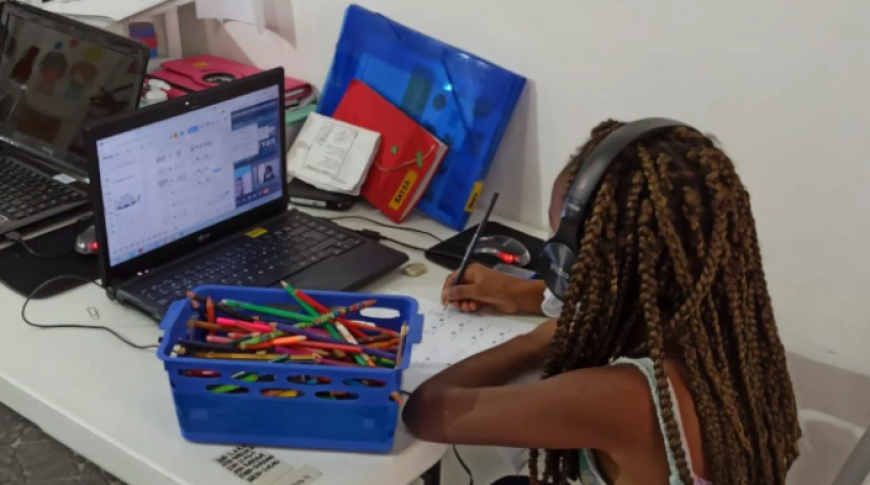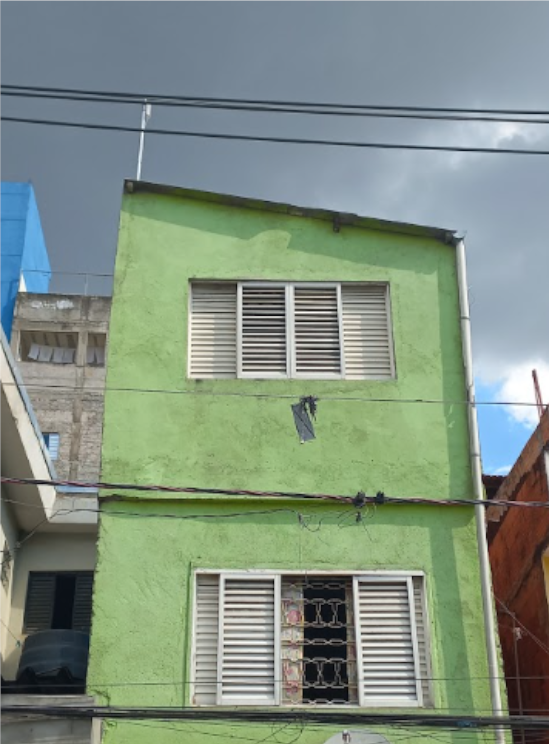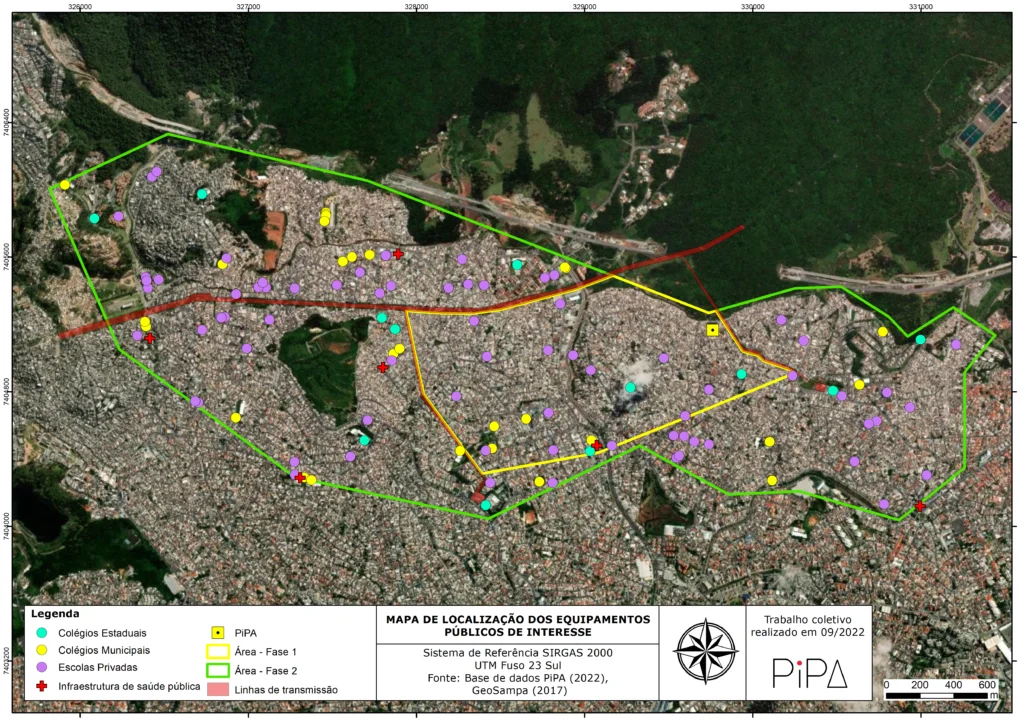
In the heart of an urban periphery of São Paulo city, where opportunities are generally limited, an inspiring initiative is developing: the construction of the community network, Novo Futuro. The objective of this ambitious project is to bring quality educational content to local residents who face structural obstacles in accessing resources such as preparatory courses, vocational courses, video classes, books and job boards. Here, we present the journey of our small collective, our successes and challenges faced along the way, particularly the problems we encountered during the construction of a community network such as the presence of many slums, a high population concentration, and difficulties in involving the local community in the project.
Unveiling the layers of the urban periphery
To a large extent, the districts of Brasilândia and Cachoeirinha, located in São Paulo, a city full of paradoxes, symbolise the realities of many Brazilian urban peripheries, although their characteristics are unique. Living in these areas means being immersed in a complex net of inequalities and limitations, where access to resources and opportunities is often scarce or remote.
As per Brazilian geographer Milton Santos’s definition, this reality can be understood as a socio-spatial segregation related to the unequal division of urban space in socio-economic terms and excluding certain social groups in specific areas of cities, meaning a concentration of poverty, structural insecurity and limited access to basic services in certain regions. This creates an environment of inequality, in which the different social classes occupy distinct spaces and have highly diverse urban experiences.
This dynamic of segregation creates some visible barriers and others that are invisible, just because a significant section of society never needs to travel through such areas, ignoring the reality of the city and contributing towards perpetuation of the exclusion that limits the development potential of communities.
Education in the periphery drives us
In 2008, a group of friends started the Preparando o Futuro – Cursinho Popular, currently one of the projects of the Associação PiPA (PiPA is a non-profit organisation founded in 2018, but which has actually been operating in this part of the city since 2008). The objective of this project is to provide complementary education to teenagers in the ninth year of basic schooling, preparing this youth for the state evaluation (SAT-type) of the State Technical Schools, locally known as ETECs (Escolas Técnicas Estaduais in Portuguese) of São Paulo. These educational challenges deepened with the advent of the COVID-19 pandemic.
Commercial telecommunications infrastructure is inadequate in these areas, creating a digital divide that merits considerable concern. Residents face difficulties accessing educational resources, employment opportunities, and public services online, which further amplifies the existing inequalities.
Added to this scenario of segregation, lack of access to quality internet aggravated the pandemic’s effects on education in the region, including on the project that was conducted on a fully in-person basis until then.
Analysing the situation, we decided to build an accessible and reliable connectivity infrastructure, the Novo Futuro community network, to enable the community to share content via intranet and/or internet access, opening the door to a world of possibilities.
During 2020, we obtained the resources to start building the community network with the support of the Tide Setubal Foundation and many individuals who were willing to donate financial resources and time both towards the construction of the network and creation of educational content that aligned with the project’s purpose. The idea was for the youth to use the community network to access relevant educational content, such as study materials, video classes and exercises, which would help them to effectively prepare for academic and skill evaluations.
The first steps are never easy
In August 2021, the idea of the community network started to become a reality and we initiated studies on different areas of knowledge that we were lacking. Using the Cartilha da MariaLab – “Enredando territórios de cuidado: guia para aprendizado e construção de Redes Comunitárias” as support material, we partnered with the Brazilian organisation Instituto Pedro Macambira and negotiated with the Casa dos Meninos association for support in learning about the different types of antennas, signals, ideal installation sites and necessary equipment. To this end, we did a detailed analysis on each piece of equipment and its operation in order to identify the best installation sites to meet the community’s needs. Using these studies, in October 2021, it was possible to configure and install the first fully operational antenna with maximum efficiency in terms of signal and range.

Photo: View of the front of the Associação PiPA and the first installed antenna.
We sometimes stumbled
Technology alone is not the only solution for the problems we were facing. Soon after installation of the first antenna, we realised that the challenge was not only limited to installing antennas, routers and repeaters. We learnt that, in order to be truly community-based, the active participation of residents and local organisations was necessary to ensure effective community network management and infrastructure maintenance.
The next difficulty was related to obtaining authorisation for installing antennas at various sites, both in the homes of people who would use the network as well as those who do not necessarily need it. Our initial attempts were rebuffed, much to our frustration. However, we knew that we needed to ensure effective communication and signal transmission and that there was an “ideal topology” to ensure antenna functionality and the success of future installations. How, then, to find a way for the network to be functional?
Receiving valuable support
Happily, we received the valuable support of the APC (Association for Progressive Communications) and Rhizomatica that, through their Communities of Practice,* allowed us to interact with other community networks and exchange experiences. We were benefited by the presence of the geographer, Jéssica Lozovei. We conducted three-day workshops and studied the region’s topology in depth. We discussed signal transmission in greater detail, increasing the opportunity to choose new installation sites for antennas in the region.
We learnt about essential geoprocessing tools such as MDE (Modelos Digitais de Elevação in Portuguese), contour lines, the software and we are still discussing the possibility of drones. We were prompted to learn about these tools in greater detail, and the results of these studies could be viewed on maps that further enhanced our planning.

Map presenting the area covered by the first and second phases, highlighting the location of public infrastructures relevant to expansion of the community network.
In addition, we jointly studied the concept of the Fresnel zone and its potential impact on the construction of our community network. This study improved our understanding of some of the difficulties faced with signal tests and new installation sites for the new antennas. We learnt that the concept of “targeted” – the possibility of seeing one site from another – was not sufficient, and that checks were need to determine whether the Fresnel zone was sufficient to avoid generation of “echoes and noise”. For this reason, installations are in homes that were brick structures, as we do not have the resources to build large towers.
Using old maps, on the second day of the workshop, we simulated installation of different antennas using applications such as Radio Mobile, Pathloss and ISP Design Center. This study allowed us to plan future installations more accurately, taking into account fewer hops and use of antennas, routers and shorter-range repeaters, enabling potential new pathways and creating a “tighter web”.
Finally, on the third and last day of the workshop, we focused on developing a system prototype, which should progress along with new installations, contributing significantly towards the community network expansion process.
Based on this study, we managed to make progress in terms of the technical difficulties, but community involvement and authorisation to use homes for testing and tower and antennas placement is an ongoing and challenging task. Without the participation of residents, it is difficult to conduct tests of possible installation sites.
Overcoming challenges and engaging the community
The difficulties we faced led us to consider possible forms of community engagement, and this brought us even closer to our mission of improving access to education and digital inclusion in urban peripheries.
Our community network vision goes beyond providing internet access to the peripheries; since the beginning, our goal has always been to provide access to specific content and not the entire internet, so we have tried to actively involve more local residents and organisations in the effective construction of the network, in terms of both management and infrastructure. To this end, we plan to offer games and other services on the server, apart from educational content such as courses on entrepreneurship, with the objective of building capacities of small local merchants, offering opportunities for growth and strengthening the sustainability of the community network. We hope that these actions will bring us closer to the people and facilitate installation of antennas in their homes and businesses, gradually expanding and funding the Rede Comunitária Novo Futuro.
For now, our next steps entails the creation of an inclusive and collaborative environment, where each resident and each organisation present and active in the area is invited to join in building and growing the network. We believe that this collective approach is fundamental in strengthening community ties, promoting equal opportunities and driving sustainable development in the area.
We remain committed to expanding horizons**, sharing knowledge and promoting social change, believing that a more egalitarian and promising future is possible, one in which technology and education are real instruments of change in communities. We hope that our experience will inspire and motivate the emergence of other similar initiatives and that more urban and peripheral communities will use this technology for local empowerment.
* The initiative mentioned was part of the Community of Practice on Sustainability, which sought, through interaction between different community networks and supporters, to investigate the difficulties of starting and maintaining community networks in different contexts (rural and urban) and to encourage research and action to enable new community networks to emerge in a sustainable way, both financially and socially. To find out more about the communities of practice and some of the topics they study, check out this series of manuals developed by them.
** According to the PiPA Association's website, the community network currently has 3 antennas installed and the expectation is to reach 10 antennas by 2024, bringing access to the students of their complementary education project.
The article was developed in collaboration with Bruna Zanolli, who is the Innovation, Technology and Sustainability (ITS) co-coordinator of the Local Networks initiative, led by APC and Rhizomatica.
Images: courtesy of the PiPA association